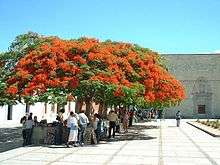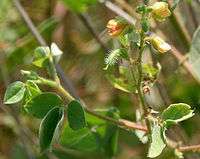Caesalpinioideae
| Caesalpinioideae | |
|---|---|
 | |
| Royal Poinciana, Delonix regia | |
| Scientific classification | |
| Kingdom: | Plantae |
| (unranked): | Angiosperms |
| (unranked): | Eudicots |
| (unranked): | Rosids |
| Order: | Fabales |
| Family: | Fabaceae |
| Subfamily: | Caesalpinioideae |
| Clades | |
|
See text. | |
| Synonyms | |
| |

Caesalpinioideae is a botanical name at the rank of subfamily, placed in the large family Fabaceae or Leguminosae. Its name is formed from the generic name Caesalpinia. It is known also as the peacock flower family.
The Caesalpinioideae are mainly trees distributed in the moist tropics, but include such temperate species as the honeylocust (Gleditsia triacanthos), Kentucky coffeetree (Gymnocladus dioicus), and redbud (Cercis canadensis). Their flowers are zygomorphic, but are very variable. Nodulation is rare in this subfamily, and where it does occur, nodules have a primitive structure.
In some classifications, for example the Cronquist system, the group is recognized at the rank of family, Caesalpiniaceae.
Distinguishing characters:
- Leaves usually paripinnate or binary
- Flowers slightly irregular, zygomorphic
- Ovary superior
- Fruits dehiscent or indehiscent
- Raceme inflorescence
The subfamily Caesalpinioideae contains 180 genera in all over the world.
Floral formula - % ○+ K(5)or5 C5 A10 G_
Taxonomy
Until recently the Caesalpinioideae were divided into four tribes (Caesalpinieae, Cassieae, Cercideae, and Detarieae). However, modern molecular phylogenetics have shown that these groupings were somewhat artificial. The most important finding was that the Papilionoideae and Mimosoideae arose from within the Caesalpinioideae,[1] thus the Caesalpinioideae (as currently circumscribed) are paraphyletic. Therefore, they are likely to be split into several subfamilies, although it is not yet clear what those subfamilies should be.[1]
- Deteriaeae sensu lato Clade
- Caesalpinieae Clade
- Cassieae Clade
- Cercideae Clade
- Dialiinae Clade
- Dimorphandra Group A
- Burkea
- Campsiandra
- Dimorphandra pro parte
- Dinizia Ducke
- Mora
- Dimorphandra Group B
- Papilionoideae
- Peltophorum Clade
- Tachigali Clade
- Umtiza Clade
- Unassigned
Phylogenetics
Caesalpinioideae, as traditionally circumscribed, is paraphyletic. Several molecular phylogenies have shown that the other two subfamilies of Fabaceae (Faboideae and Mimosoideae) are both nested within Caesalpinioideae.[2][3][4]
| Fabales |
| |||||||||||||||||||||||||||||||||||||||||||||||||||||||||||||||||||||||||||||||||
| |
Asterisks (*) indicate clades traditionally assigned to Caesalpinioideae; the other two subfamilies (which are nested within Caesalpinioideae) are underlined.
References
| Wikimedia Commons has media related to Caesalpinioideae. |
| Wikispecies has information related to: Caesalpinioideae |
- 1 2 Wojciechowski MF, Mahn J, Jones B (2006). "Fabaceae". The Tree of Life Web Project.
- ↑ Bruneau A, Forest F, Herendeen PS, Klitgaard BB, Lewis GP (2001). "Phylogenetic Relationships in the Caesalpinioideae (Leguminosae) as Inferred from Chloroplast trnL Intron Sequences". Syst Bot. 26 (3): 487–514. doi:10.1043/0363-6445-26.3.487.
- ↑ Bruneau A, Mercure M, Lewis GP, Herendeen PS (2008). "Phylogenetic patterns and diversification in the caesalpinioid legumes". Botany. 86 (7): 697–718. doi:10.1139/B08-058.
- ↑ Cardoso D, Pennington RT, de Queiroz LP, Boatwright JS, Van Wykd BE, Wojciechowskie MF, Lavin M (2013). "Reconstructing the deep-branching relationships of the papilionoid legumes". S. Afr. J. Bot. 89: 58–75. doi:10.1016/j.sajb.2013.05.001.